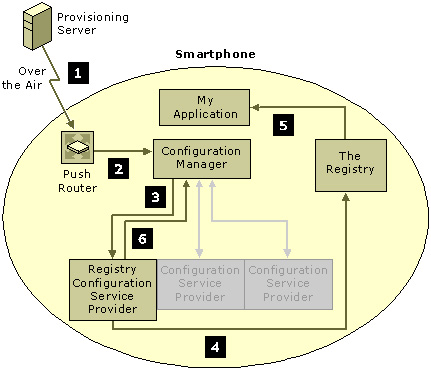 Important: Important: |
|---|
| This is retired content. This content is outdated and is no longer being maintained. It is provided as a courtesy for individuals who are still using these technologies. This content may contain URLs that were valid when originally published, but now link to sites or pages that no longer exist. |
A mobile operator can configure registry settings for Windows Mobile devices over the air by using XML packages. Configuring the registry settings over the air gives the mobile operator flexibility for managing services. For example, applications that were previously installed on the device can be activated by changing registry settings.
 Security
Note: Security
Note: |
|---|
| Configuration data is not encrypted when sent over the air (OTA). Be aware of this potential security risk when sending sensitive configuration data, such as passwords. |
The following example illustrates activating an application that a mobile operator previously installed on the device. Following the diagram are the steps for activating an application.

The following steps describe the process of activating a previously installed application:
-
XML package sent
The XML package is sent to the device over the air. The following is an XML code example:
For information about the provisioning file syntax for different OMA Client Provisioning versions, see OMA Client Provisioning Files. Copy Code
Copy Code
<wap-provisioningdoc> <characteristic type="Registry"> <characteristic type="Registry\HKLM\Software\Operator\MyApplication"> <parm name="Activate" value="1" datatype="boolean"/> </characteristic> </characteristic> </wap-provisioningdoc>
-
XML package accepted
The Push Router accepts the XML package, identifies it as a configuration package, and sends it to Configuration Manager. -
XML parsed
Configuration Manager parses the XML and sends it to the appropriate Configuration Service Provider — in this case, the Registry Configuration Service Provider.
Configuration Manager also ensures that the XML document has sufficient permission to change the specified registry key. Security roles are checked and enforced. -
Registry changed
The Registry Configuration Service Provider enforces the change in the registry, provided that role and signature requirements were met. -
Application activated
In the preceding diagram, My Application is activated due to the change of the corresponding registry entry. -
Success/failure message sent
The Registry Configuration Service Provider sends a response to Configuration Manager that indicates the success or failure of the transaction.







 See Also
See Also